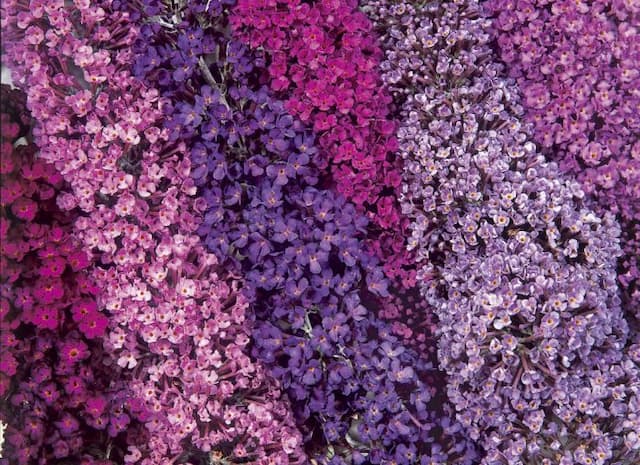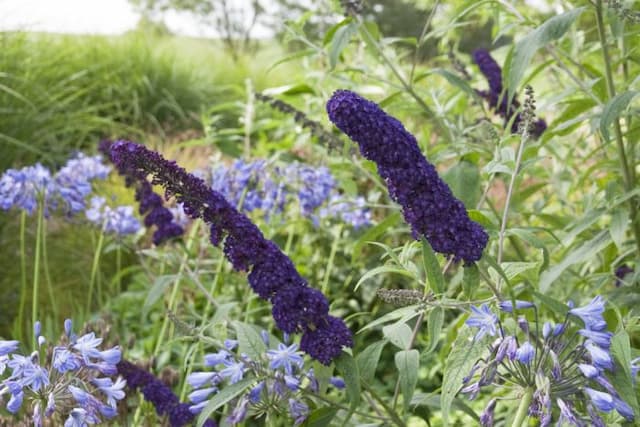Twinspur Daydream Diascia fetcaniensis 'Daydream'

ABOUT
Diascia fetcaniensis 'Daydream', commonly known as the Twinspur 'Daydream', is a delicate flowering plant that boasts a soft, romantic appearance. It has an airy and graceful habit, giving it a dreamlike quality. The plant is graced with lush, green foliage that provides a perfect backdrop for its stunning blooms. It showcases a profusion of small, closely clustered flowers that are shaped like little trumpets or spurs, which is the inspiration behind its name. These charming blossoms are usually flushed in a pretty shade of pale pink, lending a gentle splash of color to gardens or patios. The Twinspur 'Daydream' has stems that are slender and sometimes sprawling, with a tendency to produce a dense mass of greenery. Flowers typically have a characteristic yellow or orange center, creating a delightful contrast with the pink petals. This contrast is not only attractive to human admirers but also appealing to pollinators like bees and butterflies. The overall aesthetic of the plant is one of daintiness and subtle beauty, making it an ideal choice for gardeners looking to add a touch of whimsy to their outdoor spaces. Due to its appealing appearance, the Twinspur 'Daydream' is often used in borders, containers, and hanging baskets, where its delicate flowers can cascade of foliage for a magical effect.
About this plant
 Names
NamesSynonyms
Twinspur
Common names
Diascia fetcaniensis 'Daydream'.
 Toxicity
ToxicityTo humans
The Diascia 'Daydream', commonly known as Twinspur, is not known to be toxic to humans. There are no widely recognized symptoms of poisoning because it is generally considered non-toxic. Consequently, ingesting parts of this plant is not expected to result in poisoning or adverse health effects. However, it’s always prudent to avoid eating plants that are not specifically grown for consumption, as they can cause unexpected reactions or be potentially harmful due to other factors such as pesticides.
To pets
The Twinspur is not known to be toxic to pets. There are no reported symptoms of poisoning from ingestion of this plant in animals such as dogs and cats. In general, the Diascia 'Daydream' is considered safe for pets, and ingestion is unlikely to lead to toxic consequences. Despite its non-toxic status, it is still advisable to prevent pets from consuming plant material to avoid potential gastrointestinal upset.
 Characteristics
CharacteristicsLife cycle
Perennials
Foliage type
Semi-deciduous
Color of leaves
Green
Flower color
Pink
Height
1 foot (30 cm)
Spread
1 foot (30 cm)
Plant type
Herb
Hardiness zones
8
Native area
South Africa
Benefits
 General Benefits
General Benefits- Aesthetic Appeal: The Diascia 'Daydream' adds visual interest to a garden with its delicate blooms and vibrant colors.
- Attracts Pollinators: It is known to attract bees and butterflies, which are beneficial for pollination of gardens and surrounding flora.
- Extended Blooming Season: This plant typically has a longer flowering period, providing color and vibrancy for an extended time.
- Easy to Grow: Diascia 'Daydream' is considered easy to grow and maintain, making it suitable for gardeners of all skill levels.
- Drought Tolerance: Once established, it may exhibit some drought tolerance, reducing the need for frequent watering.
- Versatile Use: It's suitable for borders, rock gardens, containers, and hanging baskets, offering various landscaping applications.
- Compact Size: Its relatively small size enables it to fit into various garden spaces without overwhelming other plants.
 Medical Properties
Medical PropertiesThis plant is not used for medical purposes.
 Air-purifying Qualities
Air-purifying QualitiesThis plant is not specifically known for air purifying qualities.
 Other Uses
Other Uses- Artistic Reference: Diascia is often used by botanical artists and illustrators as a subject for their artwork due to its delicate flowers and interesting structure.
- Educational Tool: Biology teachers may use Diascia as a living specimen to demonstrate plant anatomy and pollination mechanisms to students.
- Culinary Garnish: Although not widely known for its edibility, the delicate blossoms of Diascia can be used to add a decorative touch to salads and desserts.
- Photography Subject: The vibrant colors and unique form of Diascia flowers make them a popular subject for photographers specializing in macro and nature photography.
- Crafting: Dried Diascia flowers can be used in crafting, such as creating floral arrangements, pressings, or in potpourri mixes.
- Natural Dye: Although not commonly used, the petals of Diascia can be boiled to extract natural dyes for coloring fabrics or other materials.
- Garden Structure Companion: Diascia can be planted alongside vines or plants requiring support, where its upright habit can provide a subtly supportive structure.
- Companion Planting: Diascia may help attract pollinators to vegetable gardens, potentially increasing the yield of crops like tomatoes and peppers.
- Mood Enhancer: Simply having Diascia in a living or working space can contribute to an improved mood and atmosphere due to its bright flowers and aesthetically pleasing form.
- Thematic Landscaping: Diascia can be incorporated into specific garden themes, such as a butterfly garden, due to its appeal to specific pollinators.
Interesting Facts
 Feng Shui
Feng ShuiThe Twinspur is not used in Feng Shui practice.
 Zodiac Sign Compitability
Zodiac Sign CompitabilityThe Twinspur is not used in astrology practice.
 Plant Symbolism
Plant Symbolism- Perseverance: Diascia, also known as twinspur, often continues to bloom throughout the growing season, symbolizing the ability to endure and persist.
- Attraction: With its bright and alluring flowers, twinspur can represent magnetism and the power of attraction in both nature and personal endeavors.
- Companionship: The name twinspur suggests a dual nature, which can symbolize companionship and the importance of having support from others.
 Water
WaterFor Twinspur 'Daydream', consistent moisture is important, so water the plant when the top inch of soil feels dry, which can mean watering every few days during hot, dry periods. Water the plant thoroughly, ensuring that water reaches deep into the root zone. You might use about half a gallon for a medium-sized pot every watering session. During the cooler months, reduce watering frequency as the plant's water needs decrease. It is important not to let the plant sit in waterlogged soil, as this can lead to root rot.
 Light
LightTwinspur 'Daydream' thrives in full sun to partial shade conditions. Ideally, place the plant in a spot where it receives at least 6 hours of sunlight daily. If growing indoors, a south-facing window is a suitable location as it provides ample light without the harsh midday sun which can be too intense.
 Temperature
TemperatureTwinspur 'Daydream' prefers moderate temperatures and can typically withstand a minimum of 30 degrees Fahrenheit and a maximum of around 80 degrees Fahrenheit. The ideal temperature range for this plant is between 60 and 70 degrees Fahrenheit, offering the best growth conditions without stress from extreme heat or cold.
 Pruning
PruningPrune Twinspur 'Daydream' regularly to encourage bushier growth and more blooms. Deadhead spent flowers to promote continued blooming throughout the season. Light pruning can be done at any time, but a more substantial cutback to reshape the plant is best done in early spring. Pruning every few weeks to remove leggy stems and wilted flowers can keep the plant looking its best.
 Cleaning
CleaningAs needed
 Soil
SoilTwinspur 'Daydream' thrives in a well-draining, loamy soil mix with a pH range of 5.8 to 6.5. Incorporate organic matter such as compost to enrich the soil and ensure good drainage with perlite or coarse sand.
 Repotting
RepottingTwinspur 'Daydream' should be repotted every 1-2 years or when it outgrows its current pot, to refresh the soil and allow for continued growth.
 Humidity & Misting
Humidity & MistingTwinspur 'Daydream' prefers moderate humidity levels, but it is quite adaptable and does not require specific humidity adjustments.
 Suitable locations
Suitable locationsIndoor
Place Twinspur 'Daydream' in bright indirect light indoors.
Outdoor
In well-draining soil, place 'Daydream' in full sun to partial shade.
Hardiness zone
9-11 USDA
 Life cycle
Life cycleDiascia 'Daydream', also known as Twinspur, begins its life cycle as a seed, which when sown, germinates to produce a small seedling. The seedling then develops into a vegetative plant, growing stems, leaves, and an extensive root system. As it matures, the Twinspur enters the flowering stage, where it produces its characteristic spurs and colorful blooms that are often pink, red, or orange. After pollination, often aided by bees, it sets seed, completing the reproductive cycle. These seeds can be dispersed by wind or animals, and once in a suitable environment, they will germinate, giving rise to new plants. Throughout its life, Diascia 'Daydream' may undergo periods of dormancy during colder months, resuming growth with the return of favorable conditions.
 Propogation
PropogationPropogation time
Spring to Summer
Propogation: The most popular method for propagating Diascia, commonly known as Twinspur, particularly the 'Daydream' variety, is through softwood cuttings. This process typically takes place in late spring or early summer. You start by selecting healthy, non-flowering stems and cutting them to a length of 3-4 inches (8-10 cm). Strip the lower leaves from the cutting to expose the nodes, which is where the roots will develop. Dip the cut end in rooting hormone to encourage root growth. Then, plant the cuttings in a well-draining soil mix, ensuring that at least one node is below the soil surface. The cuttings should be kept moist and in bright, indirect light until roots have developed, which usually takes several weeks. Once the cuttings have established a strong root system, they can be transplanted to their final location.


![Butterfly bush [Adonis Blue]](/_next/image?url=https%3A%2F%2Fplants-admin.emdemapps.com%2Fimages%2Fplants%2F%2Fimages%2F604b56e58f983.png&w=640&q=75)


![Butterfly bush [Buzz Ivory]](/_next/image?url=https%3A%2F%2Fplants-admin.emdemapps.com%2Fimages%2Fplants%2F%2Fimages%2F604b57987dfa8.png&w=640&q=75)
![Butterfly bush [Camberwell Beauty]](/_next/image?url=https%3A%2F%2Fplants-admin.emdemapps.com%2Fimages%2Fplants%2F%2Fimages%2F604b5ead04c12.png&w=640&q=75)


